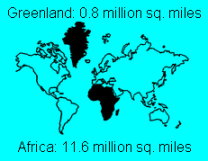In a recent comment here on this blog the relevance of Master Data Management (MDM) solutions was questioned because in real business life different business units sees master data very differently though the data describes the same real world entity. And it’s not the first time I hear this argument.
 The issue is similar to the Greenland problem in geography. When using the most common projection for visualizing a round earth on a flat map, the Mercator projection, Greenland has a true shape but will look as being of same size as Africa, though Africa is over 10 times as large as Greenland.
The issue is similar to the Greenland problem in geography. When using the most common projection for visualizing a round earth on a flat map, the Mercator projection, Greenland has a true shape but will look as being of same size as Africa, though Africa is over 10 times as large as Greenland.
As examined in the post Sharing data is key to a single version of the truth this is similar to the problems in fulfilling multiple uses embracing all business units in an enterprise:
- If a map shows a limited part of the world the difference doesn’t matter that much. This is similar to fitting the purpose of use in a single business unit.
- If the map shows the whole world we may have all kind of different projections offering different kind of views on the world having some advantages and disadvantages like when we do enterprise MDM.
Today we have new technology coming to the rescue. If you go into Google Earth the world indeed looks round and you may have any high altitude view of an apparently round world. If you go closer the map tends to be more and more flat.
 My guess is that the solutions to fit the multiple uses conundrum within MDM also will be offered from the cloud by having innovative solutions reflecting the real world entities and relate those to a variety of business functions used in different business units offering a range of views that supports multiple purposes of use.
My guess is that the solutions to fit the multiple uses conundrum within MDM also will be offered from the cloud by having innovative solutions reflecting the real world entities and relate those to a variety of business functions used in different business units offering a range of views that supports multiple purposes of use.
Hi Henrik; I heard it said once that all local geometries are Euclidian, and that the further out (up) you go the less ‘useful’ that geometry becomes, It’s why, among many, many other things, airplanes don’t use straight lines as the shortest path to their destinations. MDM (and I would argued all other digital applications) is Euclidian. No wonder integration is difficult if not impossible!
Now we have identified the problem…who is up for the solution?
John. The representation of geocodes is a good example of how to cope different views.
You can easily use Pythagoras’ theorem with UTM coordinates to calculate a short distance in meters between two points not being too north or too south.
For a global view latitude and longitude degrees are better.
Use, or at least reference, both.
Thanks Henrik, but I was speaking along a more metaphorical line. Your Greenland example is a great illustration of what ails all information management efforts when approached from the ‘flatland’ of technology. Greenland looks the same size as Africa on a flat map just as the word ’emergency’ looks identical to an idexing engine whether it refers to an Event, a Status, and Organization or a Physical location in a Hospital. To my way of thinking, the effect is the same as the Greenland effect: search results do not care how you intended to use the original string, it just cares that it found a ‘match’. It would be analogous to asking Google Maps to find a location by only giving it latitude.
As you correctly pointed out, we need to begin to ‘triangulate’ in order to get to more robust information,management.
when you get to the individual attribute level there is some absolute right and wrong – the address is correct, the individual’s last name is correct, the part number is correct. part of what we see is that data is put to never envisioned uses, that is never envisioned when the system was designed 30 years ago. this is where different perspectives come into play, so while the data as-is might be “good” it does not meet some current requirements and therefore is seen as “bad”.